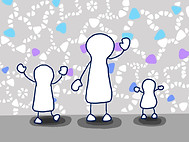

An Inclusive System of Illuminated, Multi-Sensory Ceramic Tiles
Inspired by the concept of time, to support moments of "waiting" in children's hospitals
Team "Les Misses":
Two students from different design disciplines and cultural backgrounds, connected by a passion for inclusive design
Ana-Paola Laveaga
Spatial Experience Design | Artcenter College of Design
Maiko Konuma
Product Design | TAMA Art University
Design Challenge:
An exploration of crossing new digital techniques with ancient hand making traditions, learning from the wisdom of craft.
CERAMIC FUTURES
Project Brief:
A PACIFIC RIM 15 Collaboration
The 15th session of an international educational initiative between Tama Art University and ArtCenter College of Design to develop advanced human resources through collaboration in creative fields.
Our Guiding Design Question
How might ceramics create inclusive experiences in a hospital setting that re-imagine the process of waiting?

A key consideration for TOKI was to understand where moments of waiting might take place in a children’s hospital.

It was also important to understand that for every child entering a hospital, there is always a parent or guardian who joins.
Discovering Moments of Waiting
Our goal was to create a design solution that affords being mounted on existing hospital walls
Our Design Solution

As a result of having two key audiences, our system of tiles is made of two key elements:
A design for children that is about
touching time.
Our Inspiration

We had the pleasure of interviewing a father who made several trips to the hospital to seek care for his daughter who was being given hearing implants.

Like him, many families spend weeks or months at a time in a hospital setting for their child’s treatments.
This particular family had two adults, and two children; one non hearing child and one child with hearing.

After hearing how these hospital visits became repetitive, tiresome, and difficult, we began re-imagining these moments of waiting that the family was experiencing.
Each member had a different set of abilities and therefore a different experience and set of needs.
We found opportunities in public spaces like the reception waiting area, but also in more private spaces like patient rooms.
Corridors and hallways are
transitional moments of time where one might also be waiting or trying to find a change of environment.


And a design for adults that is about the
feeling of time.

When the two elements of the toki system coexist within a space, relaxing and playful moments of discovery are created for families.
One illumination is controlled mechanically like a clock.
While in the other, the child controls the source of light.


“touching time”
toki interactive tiles
Illuminated ceramic tiles offer opportunities for educational play, illustrating concepts of time like sunrise and sunset. The tiles also may serve as occupational therapy, or to help develop fine motor skills, because they come in various sizes with fun textures and interactions.


Interactive Tiles Process



Our fabrication method for tiles of various sizes was slip casting.
To achieve the larger tiles, 3D prints were created and then used to create plaster molds.
The smaller tiles were created using hand made plaster molds, and the surface pattern was achieved by a traditional method of "tatara".

tatara - a traditonal method of pressing patterns onto clay by adding pressure and using another surface as a stamp.

“feeling time”
toki texture clock
A porcelain wall light that allows for the passing of time to be meditative and for the experience of waiting to be re-imagined as a story of texture, light and shadow.



Texture Clock Process
Using Arduino, we programmed the movement of light and tested its effects on the 3D print





In order to achieve this undulated surface, we created a digital model that we could easily manipulate to create the desired shape, curvature, and even test light and shadow.
This was then 3D printed and used to create a plaster mold that we could then use as a surface for "tatara".

Our method of tatara we developed was a cross between traditional and digital.
We designed a stamp digitally and then 3D printed the stamp in two forms, for ease of applying patterns of different sizes and depths onto the clay.

Our favortie part was adding in the details by hand and playing with the depressions and projections of the patterns
Finally, we used a slab method to create the lip where the LED strip would rest and cast light onto the rest of the piece.



Early Explorations
















Final Presentation - Gallery Exhibit










